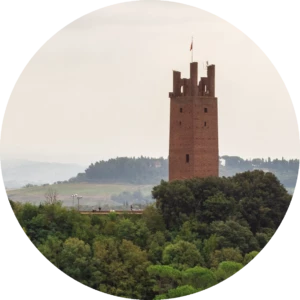Historical overview
11-01-2022 09:33 - Via Francigena, History, What to visit
San Miniato and the rich Arno valley where it sets have been inhabited since the Bronze Age. Etruscan and Roman settlements have been discovered throughout the territory too. But the birth of the village, the City of San Miniato, has a later date: it is in 783 when a group of Lombards built and dedicated a little church to the martyr Miniato (today the Church of San Francesco).
The Middle Age is a time of splendor for the City of San Miniato. The German Emperor Frederick Barbarossa, and his son Frederick II of Swabia played a key role in the construction of the medieval city and his historical legacy. During the Middle Ages, the Holy Roman Empire based in San Miniato their strategic quarter to administrate and collect the taxes in central and northern part of Italy. Thanks to this upgrade the town grew in shape and reputation. The town took shape of a castle with two-ring wall (shaping an 8 or ∞ infinity), an imperial palace, many sacred buildings and other dwellings used for trade. Important changes took place in the territory: the ancient road and pilgrimage route running from the city of Canterbury in England to Rome (Via Francigena) was diverted so to pass through the city, giving San Miniato direct control over customs duties. The symbol of this historical period is the Rocca, the watchtower located on the highest point of the hill.

San Miniato played a fundamental role in modern and contemporary European history too: the Buonaparte family has their origins in Tuscany (in Florence to be precise) and are attested already in the Middle Ages. At the time, medieval societies were divided in two factions the Guelphs (running in favor of the Pope) and Ghibellines (running for the Holy Roman Empire). The family had to leave Florence and fled first in San Miniato, later in Sarzana and centuries later in Corsica, Napoleon's homeland. The family wanted to reclaim their ancient noble title, which would allow them to be part of the Corse and French nobility. In order to do so, Napoleon undertook a journey to San Miniato, where the ancient family memebers still lived. In 1759 he made his first visit and he got recognition of the belonging to the Bonaparte branch. With this noble title, the young Napoleon was able to enter the royal military school in Paris. From there he climbed the military ranks to become a general, and the rest is history! Years later, during the Italian campaign (1810) Napoleon paid a second visit to San Miniato, to his 'uncle' Filippo, the last representative of the ancient lineage who lived in the residence in Palazzo Formichini.

Frederick II Stupor Mundi
The Middle Age is a time of splendor for the City of San Miniato. The German Emperor Frederick Barbarossa, and his son Frederick II of Swabia played a key role in the construction of the medieval city and his historical legacy. During the Middle Ages, the Holy Roman Empire based in San Miniato their strategic quarter to administrate and collect the taxes in central and northern part of Italy. Thanks to this upgrade the town grew in shape and reputation. The town took shape of a castle with two-ring wall (shaping an 8 or ∞ infinity), an imperial palace, many sacred buildings and other dwellings used for trade. Important changes took place in the territory: the ancient road and pilgrimage route running from the city of Canterbury in England to Rome (Via Francigena) was diverted so to pass through the city, giving San Miniato direct control over customs duties. The symbol of this historical period is the Rocca, the watchtower located on the highest point of the hill.

Want to visit San Miniato?
Download the guide
Buonaparte family
San Miniato played a fundamental role in modern and contemporary European history too: the Buonaparte family has their origins in Tuscany (in Florence to be precise) and are attested already in the Middle Ages. At the time, medieval societies were divided in two factions the Guelphs (running in favor of the Pope) and Ghibellines (running for the Holy Roman Empire). The family had to leave Florence and fled first in San Miniato, later in Sarzana and centuries later in Corsica, Napoleon's homeland. The family wanted to reclaim their ancient noble title, which would allow them to be part of the Corse and French nobility. In order to do so, Napoleon undertook a journey to San Miniato, where the ancient family memebers still lived. In 1759 he made his first visit and he got recognition of the belonging to the Bonaparte branch. With this noble title, the young Napoleon was able to enter the royal military school in Paris. From there he climbed the military ranks to become a general, and the rest is history! Years later, during the Italian campaign (1810) Napoleon paid a second visit to San Miniato, to his 'uncle' Filippo, the last representative of the ancient lineage who lived in the residence in Palazzo Formichini.

[ ]
[
]
[ ]
[
]
[ ]
]
information request form
 ]
[
]
[ ]
[
]
[ ]
] Request info
Bold fields are required.
